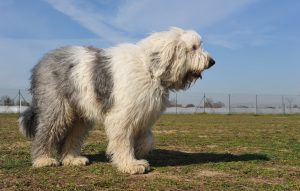Old English Sheepdog
Breed description
 Once a common sight around the UK, the Old English Sheepdog (OES) is now classed as a ‘vulnerable’ breed due to a drastic decline in its popularity. This iconically British dog is a keen herder; it has proven itself a faithful and talented working companion for many years. The OES is recognisable for its shuffling gait and is often referred to as the ‘Bobtail’ because, traditionally, the breed’s tail was docked for working. These good-natured dogs can make wonderful family pets for owners who aren’t put off by the famous shaggy coat!
Once a common sight around the UK, the Old English Sheepdog (OES) is now classed as a ‘vulnerable’ breed due to a drastic decline in its popularity. This iconically British dog is a keen herder; it has proven itself a faithful and talented working companion for many years. The OES is recognisable for its shuffling gait and is often referred to as the ‘Bobtail’ because, traditionally, the breed’s tail was docked for working. These good-natured dogs can make wonderful family pets for owners who aren’t put off by the famous shaggy coat!
The OES isn’t a particularly old breed, having fairly recent roots that can be traced to the 18th Century. The breed came about from crosses of dogs used for cattle droving, but its exact ancestry is not exactly known. It has become popular in the show ring, and these days is often found enjoying family life, rather than being a working dog.
Pros
- Trainable and obedient
- Excellent herding dog
- Friendly and good natured
Cons
- Requires dedicated coat care
- Needs a lot of exercise
- Can be stubborn
Suitable for
Properly trained and socialised, the Old English Sheepdog can fit happily into family life with children and other pets. It’s as happy on the sofa as it is out on a romp in the countryside, so, as long as its exercise needs are met, the breed makes a great family pet. Out and about, they do enjoy some stimulation with games, and their intelligent, trainable nature makes them wonderful companions for agility.
- Ideal for active individuals, couples or families
- Ideal working dog on a farm
A family looking for a good-natured dog could find their match in an Old English Sheepdog, but they must be prepared to provide proper training, plenty of exercise and dedicate time to caring for its coat.
Breed care advice
The coat is probably the main issue when it comes to caring for an Old English. It doesn’t have to be a huge amount of work, but it can’t be left to its own devices! Ideally, these dogs should be brushed daily or every other day as a minimum – it’s surprising how quickly knots and matts can form in the fur. Owing to its length, and the propensity of these dogs to get pretty grubby out on their walks, it’s a good idea to schedule a monthly bath. Keeping the coat trimmed is a good idea in the summer months, to help keep them cool, and make the coat more manageable.
Known health problems
Although the OES tends to be a dog that generally has good health, it’s important to be aware of a few conditions that the breed is known to be susceptible to.
It’s obvious that good coat care is important to keep these dogs looking their best, but the shaggy coat can also hide wounds, as well as skin and eye problems. Regular grooming sessions are helpful to these dogs, to make sure nothing untoward is hiding under that fur. The hairs around the eyes should be kept trimmed to avoid them becoming matted up and sore.
- Hereditary eye conditions – in the OES, hereditary cataracts may form at some point after birth. They can lead to vision loss and eventual blindness, requiring invasive surgery to remove in an attempt to restore vision
- Immune-mediated thrombocytopaenia – antibodies are produced against the body’s own platelets. This leads to platelet destruction, causing platelet numbers to fall too low. It can cause excess bleeding or bruising, and requires immunosuppressive medication to treat
- Hypothyroidism – Old English Sheepdogs are overrepresented amongst dogs with hypothyroidism. Antibodies are produced against the dog’s thyroid gland, damaging it and leading to signs of hypothyroidism (including lethargy, low body temperature, weight gain, skin changes and hair loss). Affected dogs are treated with medication to replace the depleted thyroid hormone levels
- Cerebellar cortical degeneration – this is a rare, hereditary condition that causes degeneration of neurological tissue, leading to signs like abnormal gait (ataxia), tremors and neurological deficits.
- Like so many big dogs, they are also at increased risk of joint conditions, including osteochondrosis of the shoulder and hip dysplasia.
Lead author: Yvette Bell MRCVS